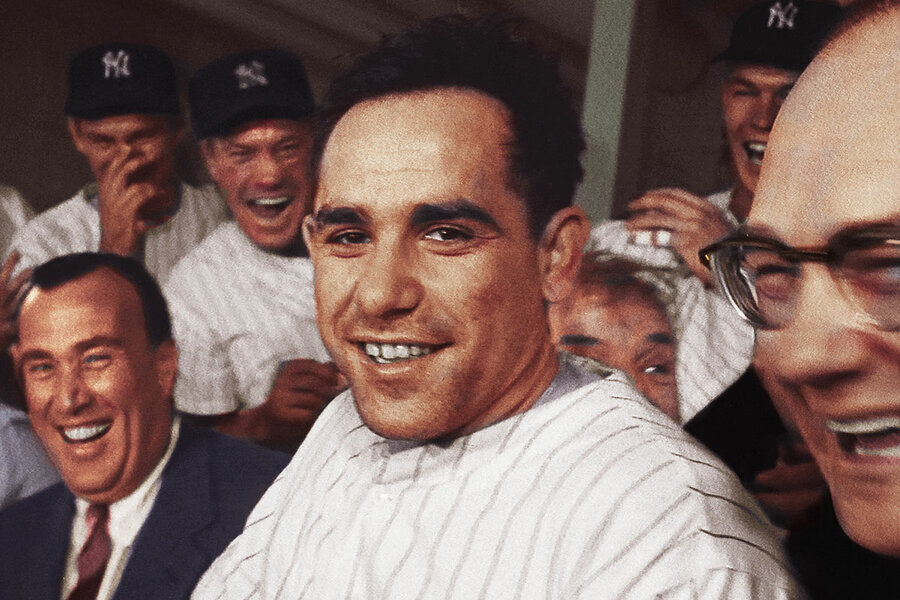Catcher and philosopher: Yogi Berra gets his due
Loading...
You might think it impossible that someone as celebrated as New York Yankees superstar Yogi Berra, whose career stretched from the 1940s to the 1980s, could ever be undervalued as a player and manager. But that’s precisely the assessment that Sean Mullin, the director of the affectionate documentary “It Ain’t Over,” aims to correct.
The film begins with a clip from a ceremony at the 2015 All-Star Game where fans had voted in the four “greatest living players” – Willie Mays, Hank Aaron, Johnny Bench, and Sandy Koufax. As Berra’s doting granddaughter and the film’s co-producer, Lindsay Berra, tells it, she was in the stadium watching the event with her still very-much-alive grandfather. They were unamused.
As recounted in the film by interviewees such as sportscasters Bob Costas and the late Vin Scully, and Yankees shortstop great Derek Jeter, Yogi’s goofy, companionable demeanor as player and, later, commercial pitchman, may have worked against people taking him seriously, at least outside the baseball world. In fact, his Hall of Fame statistics – including 10 World Series rings, three Most Valuable Player awards, a lifetime batting average of .285, and 358 home runs – mark him as perhaps the greatest major league catcher of all time.
Why We Wrote This
A story focused onWhen one of baseball’s greats seems to be overlooked, what’s the best way to correct that? The director of “It Ain’t Over” offers a documentary that looks fondly at famous Hall of Famer Yogi Berra.
He grew up in an Italian neighborhood in St. Louis as Lawrence Peter Berra and got his nickname as a teenager from a friend who pointed out that, seated on the ground, legs and arms crossed, his posture resembled a yogi.
Berra’s short, stocky build – one commentator fondly observed that he looked like a fire hydrant – didn’t remind people of a professional baseball player, let alone a mighty New York Yankee taking the field with the likes of Joe DiMaggio and Mickey Mantle. But looks can be misleading. In Berra’s case, they were downright deceiving.
He had his pride. Unceremoniously fired as manager in 1985 after just 16 games by owner George Steinbrenner, Berra refused to step inside Yankee stadium for 14 years until the boss personally apologized to him.
But mostly Berra was modest. He qualified for the Purple Heart in World War II after storming Normandy Beach, but for fear of upsetting his mother, he didn’t fill out the injury forms.
He was a master baseball strategist who knew exactly how each batter should be pitched to. In 1956 he caught the only perfect game in World Series history – no runs, no walks, no hits, no errors. Don Larsen, an otherwise journeyman hurler, was on the mound against the Brooklyn Dodgers. The image of Berra jumping into his arms after the final out is iconic. Amazingly, in 1999, on Yogi Berra Day at Yankee Stadium, with Larsen joining Yogi in the stands, Yankee pitcher David Cone threw a perfect game.
Another iconic moment, which also receives quality time in the documentary, is when Brooklyn’s Jackie Robinson stole home in the first game of the 1955 World Series. To the end of his days, Berra, who died in 2015, insisted he had tagged out his good friend. The film plays and replays in slow motion the footage of Robinson sliding into home plate. Verdict: We’ll never really know.
Even people who don’t know much about Berra or baseball are familiar with his famous Yogi-isms – tossed-off comments that at first seem nonsensical but, upon closer examination, have the ring of truth. Aside from “It ain’t over till it’s over,” there’s also “When you come to a fork in the road, take it,” and “No one goes there anymore, it’s too crowded,” or, my favorite, “You can observe a lot by watching.” Maybe Yogi was a yogi after all?
I close here with my own Berra anecdote, and it’s not pretty. As a little boy, I inherited a mint condition 1955 Yogi baseball card. I thought he looked better with a mustache, and so I drew one on him. That card, mustacheless, is now valued at several thousand dollars. Defaced, it’s worth a stick of bubble gum. Nevertheless, I still have the card.
It ain’t over.
Peter Rainer is the Monitor’s film critic. “It Ain’t Over” rolls out in theaters starting May 12. The film is rated PG for smoking, some drug references, language, and brief war images.
Editor’s note: An earlier version of this article misstated who won the 1984 pennant. It was the Tigers.








